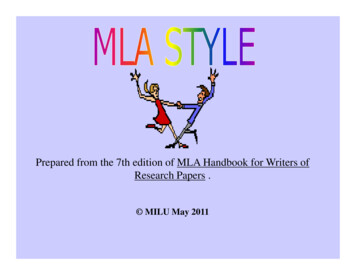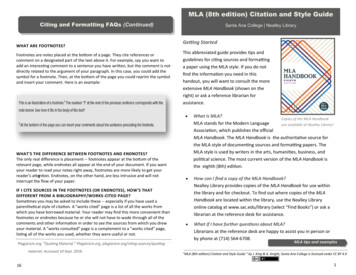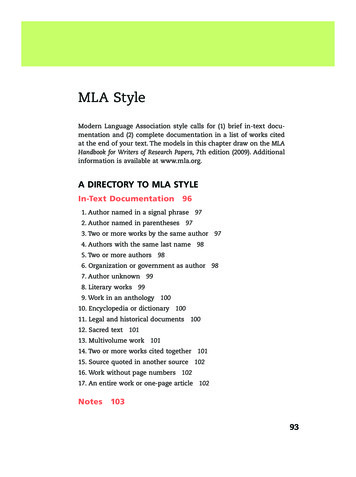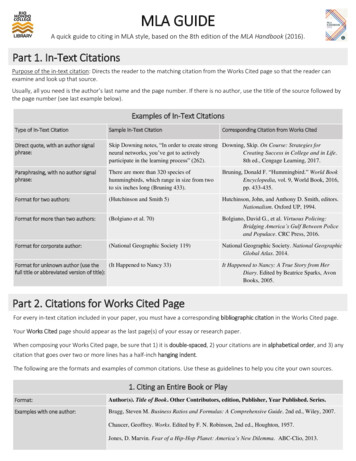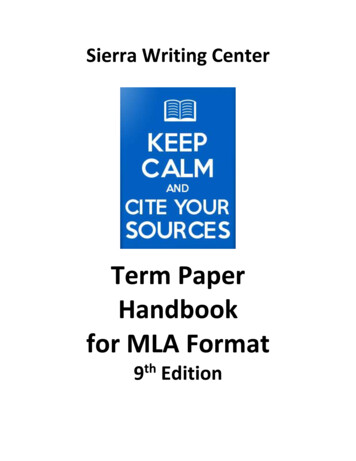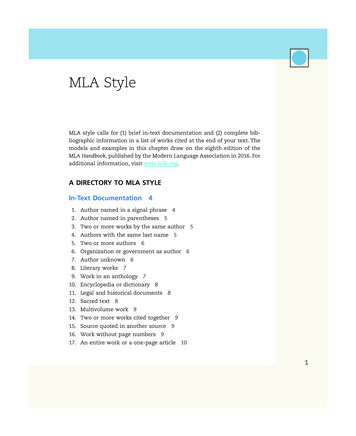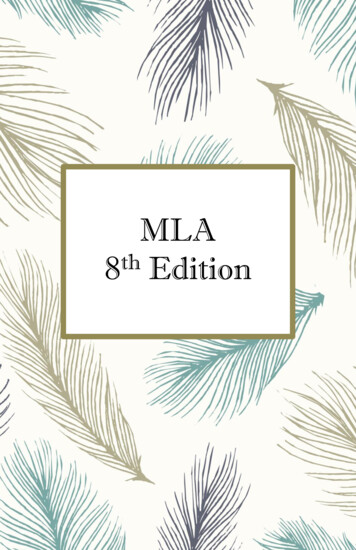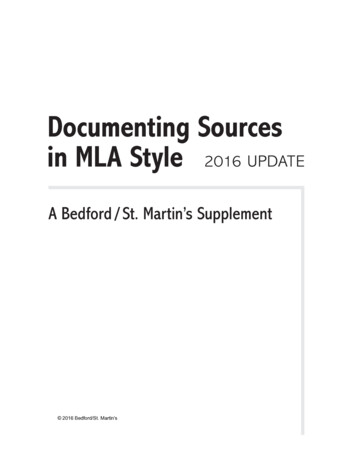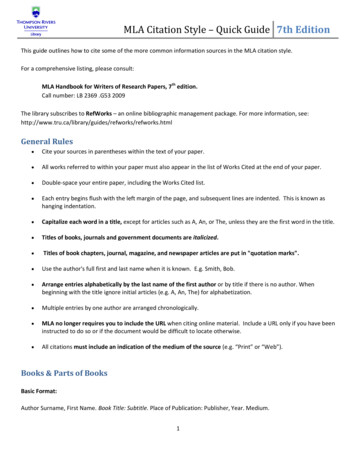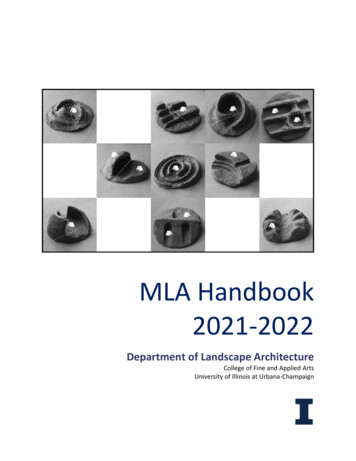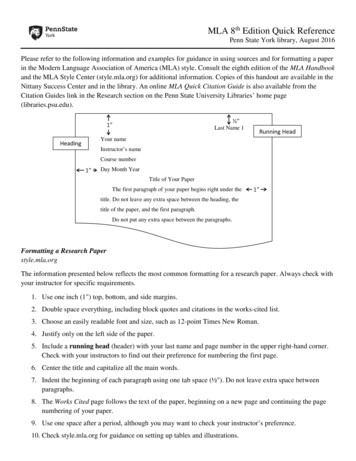
Transcription
MLA 8th Edition Quick ReferencePenn State York library, August 2016Please refer to the following information and examples for guidance in using sources and for formatting a paperin the Modern Language Association of America (MLA) style. Consult the eighth edition of the MLA Handbookand the MLA Style Center (style.mla.org) for additional information. Copies of this handout are available in theNittany Success Center and in the library. An online MLA Quick Citation Guide is also available from theCitation Guides link in the Research section on the Penn State University Libraries’ home page(libraries.psu.edu).½”1”Last Name 1Running HeadYour nameHeadingInstructor’s nameCourse number1”Day Month YearTitle of Your PaperThe first paragraph of your paper begins right under the1”title. Do not leave any extra space between the heading, thetitle of the paper, and the first paragraph.Do not put any extra space between the paragraphs.Formatting a Research Paperstyle.mla.orgThe information presented below reflects the most common formatting for a research paper. Always check withyour instructor for specific requirements.1. Use one inch (1") top, bottom, and side margins.2. Double space everything, including block quotes and citations in the works-cited list.3. Choose an easily readable font and size, such as 12-point Times New Roman.4. Justify only on the left side of the paper.5. Include a running head (header) with your last name and page number in the upper right-hand corner.Check with your instructors to find out their preference for numbering the first page.6. Center the title and capitalize all the main words.7. Indent the beginning of each paragraph using one tab space (½"). Do not leave extra space betweenparagraphs.8. The Works Cited page follows the text of the paper, beginning on a new page and continuing the pagenumbering of your paper.9. Use one space after a period, although you may want to check your instructor’s preference.10. Check style.mla.org for guidance on setting up tables and illustrations.
2Citing Sources and PlagiarismMLA Handbook, pp. 6-10In scholarship, sources are not selected to fill an arbitrary quota (e.g. “find at least five, peer-reviewed journalarticles”), but are chosen for their ability to act as compelling evidence in your papers and projects. Citingevidence, therefore, is not busy work. It performs three essential and related functions: It establishes credibility. Citations help readers see the breadth and depth of your research. Readers canalso see if you are using appropriate evidence and if you are using that evidence appropriately.It acts as a map. Scholarship is an ongoing conversation. New findings and ideas build on previousfindings and ideas; it’s how a field of study advances. Citations make those connections explicit for yourreader. Not only does this make you more credible, it helps interested researchers track down yourevidence for use in their research.It gives credit. Acknowledging those that contribute to the conversation is an essential function ofscholarship. It illustrates the debt your research owes to the research that precedes it.Citing sources is often reduced to “if you don’t give proper credit to the words and ideas of others, it’splagiarism.” There are many types of plagiarism; such as using someone else’s work and submitting it as yourown, failing to appropriately acknowledge others when quoting or paraphrasing, or presenting another’s line ofthinking as your own. Refer to the MLA Handbook for additional guidance on how to avoid plagiarism.General Guidelines for Authors and TitlesMLA Handbook, pp. 61-751. Refer to the author by his or her full name the first time it is mentioned in the text, but by last name onlythereafter, unless you have two authors with the same last name. In that case, use both the first and lastnames consistently.2. Titles of books, plays, magazines, journals, newspapers, movies, television shows, albums, and Websites are to be italicized.3. Titles of journal articles, short stories, essays, poems, and songs are in quotation marks.4. Capitalize the first and last words and all main words in the titles of your sources (e.g. “Eight Days aWeek,” Great Expectations, The Wall Street Journal, The Star-Ledger, The Simpsons, “The Raven”).Use of NumbersMLA Handbook, pp. 92-931. Spell out numbers that can be written in one or two words (four, thirty-five); use numerals to representlonger numbers (110, 5½).2. Do not begin a sentence with a numeral; either spell it out or revise your sentence.3. Following are examples of the format for inclusive numbers, including page numbers in your workscited list. The second number is given in full through ninety-nine and when necessary for 816-1,9541,955-591,425-922
3Works CitedMLA Handbook, pp. 20-53, 102-116The eighth edition of the MLA Handbook reflects a significant change from previous editions in terms of citingyour sources. In the past, you were provided specific instructions for citing sources according to their format;such as books, journal articles, and newspapers. These specific instructions have been replaced in the eighthedition with a set of principles and a list of core elements.The principles in the eighth edition of the MLA Handbook are: “Cite simple traits shared by most works” (3).“Remember that there is often more than one correct way to document a source” (4).“Make your documentation useful to readers” (4).The core elements in the eighth edition of the MLA Handbook,shown in the order they should appear in the works-cited listand with the appropriate punctuation, are:1.2.3.4.5.6.7.8.9.Author.Title of source.Title of container,Other contributors,Version,Number,Publisher,Publication date,Location.From MLA Handbook (8th ed.), published by the Modern Language Association(style.mla.org). See last page of this handout for a practice template.Keep in mind, you will only include those elements that apply to the source you are documenting.CORE ELEMENTS1. AUTHORMLA Handbook, pp. 21-25, 102-195This element ends with a period.Examples:One author:Two authors:Three or more authors:Editor:Corporate author:Bok, Derek.Berg, Maggie, and Barbara K. Seeber.von Stumm, Sopie, et al.Gallagher, Gary W., editor.United Nations.Notes Reverse only the first author’s name. The word editor is no longer abbreviated, as it was in the 7th edition. You do not have to repeat the name of an organization that is both the author and the publisher. In thoseinstances, you will begin your entry with the title; the organization will be listed as the publisher.
42. TITLE OF SOURCEMLA Handbook, pp. 25-29This element ends with a period.Titles of books and Web sites are italicized; titles of journal articles are in quotation marks. According tothe MLA Handbook guideline, use italics for sources that are “self-contained and independent” (25-26)and “quotation marks if the source is part of a larger work” (25). Use a colon between titles and subtitles.Examples:Book title:Journal article:Web site article:The Slow Professor: Challenging the Culture of Speed in the Academy.“The Hungry Mind: Intellectual Curiosity Is the Third Pillar of AcademicPerformance.”“Our History and Mission.”3. TITLE OF CONTAINERMLA Handbook, pp. 30-36, p. 107This element is followed by a comma.The term container is new to the eighth edition and refers to the “larger whole . . . that holds the source”(30). Citations may include more than one container. Titles of containers are usually italicized.For example, if your source is a poem that appears in a book, the book is the container. If your source isa journal article accessed through a library database, you will cite two containers: the title of the journaland the name of the online database. In that case, you will follow through with all the information aboutthe first container (the version, number, publisher, publication date, and location) before citing theinformation about the second container.Examples:Journal title:The Georgia Review,Web site:The Donor Sibling Registry,Journal article from library databaseContainer 1 title:Perspectives on Psychological Science,Container 2 title:Sage Journals Online,Notes: Include articles (A, An, The) if they are part of the journal’s title. Capitalize these words both in your textand in the works-cited list. This is a change from the 7th edition.4. OTHER CONTRIBUTORSMLA Handbook, pp. 37-38This element is followed by a comma.You will only need to include this element if your source included other contributors integral toidentifying your source, such as directors or translators.5. VERSIONMLA Handbook, pp. 38-39, p. 107This element is followed by a comma.One of the most common uses for this element would be numbered editions of books. You would alsoinclude information for works in other media, such as the director’s cut for a movie.Example:Book:Book:8th ed.,Rev. ed.,
56. NUMBERMLA Handbook, pp. 39-40This element is followed by a comma.Include the volume number when citing a book, if you used one volume of a multi-volume set. Whenciting a journal article, include the volume and the issue number.Examples:Book with a version:Book:Journal:2nd ed., vol. 2,Vol. 5,vol. 6, no. 6,Note: If the journal only uses issue numbers, and not volume numbers, you will just use the issue number afterthe journal title.7. PUBLISHERMLA Handbook, pp. 40-42, p. 97, pp. 108-109This element is followed by a comma.Use this element when citing a book, but do not include this information for journals, magazines, ornewspapers. The publisher of a Web site is often found in the copyright notice at the bottom of the homepage.Use the full name of the publisher, with the following exceptions: Omit business words from the publisher’s name (such as Company or Co., Corporation or Corp., andIncorporated or Inc.). Use the abbreviation UP for University Press.Examples:Book:Web site:Free Press,Princeton UP,U of Toronto P,National Aeronautics and Space Administration,Notes The place of publication is no longer included in your citation. This represents a change from the 7thedition. Omit the publisher’s name when citing a Web site if the title of the site is essentially the same as thepublisher.8. PUBLICATION DATEMLA Handbook, pp. 42-46This element is followed by a comma.Examples:Book:Journal:Journal with season:Journal with month:2016,2011,Spring 2008,Jan. 2013,Dated article on Web site:Magazine article:Newspaper article:28 May 2014,25 Apr. 2007,6 Sept. 1926,Note: Months are abbreviated in the works-cited list, with the exception of May, June, and July.
69. LOCATIONMLA Handbook, pp. 46-50, p. 110This element is followed by a period.For magazine, journal, or newspaper articles, the location refers to the page or page numbers. For onlinesources, the location is usually indicated by the URL. Copy the URL from your browser, but omit http//or https://. If your journal article includes a DOI, use that, rather than the URL.Examples:Web d-mission.Journal article from library databaseContainer 1 location:574-88.Container 2 location: doi:10.1177/1745691611421204.Notes You will have to click “Undo” if your Word program automatically formats your URL as a hyperlink.While the eighth edition recommends including URLs, check with your instructors for their preference. OPTIONAL ELEMENTSMLA Handbook, pp. 50-53Some examples of optional elements include the date of the original publication (for republishedsources), the city of publication in certain circumstances, and the date of access if the online work doesnot include the date it was published.Internal Documentation (In-text citations, parenthetical citations)MLA Handbook, pp. 54-58, 75-77, 116-127Every time you paraphrase or directly quote a source, you must give the reader the author’s last name and thepage number of the source, either in the tag (introductory) line or in parentheses. Do not use a comma betweenthe author’s name and the page number. Paraphrase wherever possible.“If you borrow more than once from the same source within a single paragraph and no other source intervenes,you may give a single parenthetical reference after the last borrowing” (MLA 124). Keep in mind, “When asource has no page numbers or any other kind of part number, no number should be given in a parentheticalcitation” (MLA 56).Author’s name in tag line“With all the controversy over the college curriculum,” writes Derek Bok, “it is impressive to findfaculty members agreeing almost unanimously that teaching students to think critically is the principalaim of undergraduate education” (109).Authors’ names in parenthesesWe begin to think we must always be busy and schedule every minute of our time, but fail to considerthat “Research shows that periods of escape from time are actually essential to deep thought, creativity,and problem solving” (Berg and Seeber 26).More than two authorsMoving from a topic to a research question can be difficult, but keep in mind, “If the writer asks noquestion worth pondering, he can offer no focused answer worth reading” (Booth et al. 45).Note: If a work has more than two authors, the in-text citation follows the format of the works-cited list. Notice thatet al., which means “and others,” ends with a period.
7Indirect quotationsUse material from original sources whenever possible. If you need to include a quotation from anindirect source, use the original author’s name in the tag line and add qtd.in (“quoted in”) before theindirect source in the parenthetical citation.Studying a foreign language in college often results in only superficial understanding; as George DennisO’Brien puts it, “Enough French to read the menu, not enough to compliment the chef” (qtd. in Bok 43).In the above example, Bok’s book would appear in the works-cited list.Work listed by titleIf there is no author, use the article or book title (or a shortened version of the title, if it is a lengthy title)before the page number. For example, a parenthetical citation to the anonymous article “Tweeting Allthe Way to the Bank” which appeared in the Economist would be formatted as (“Tweeting” 61).Citing more than one source in a single parenthetical citationIf you wish to cite more than one source, separate the citations with a semicolon.(Badke 48; Lupton 411-13).Block quotes – MLA Handbook, pp. 75-79When you quote more than four typed lines of prose or more than three lines of poetry, set off thequotation by indenting it one tab from the left margin. Long quotations should be introduced with a tagline followed by a colon. Do not use quotation marks around the material.In Our Underachieving Colleges, Derek Bok discusses the sequential nature of coursework inherentin most college majors:An introductory course can acquaint students with the principal subfields of the discipline andthe basic concepts and ideas that distinguish the field. Intermediate courses can acquaint studentswith the methods of the discipline for acquiring and analyzing information. More advancedcourses can then apply what has been learned to important problems in the field. Finally, aculminating experience – normally a substantial research paper – will allow students to draw onprevious courses and readings to gather and analyze information and ultimately produce a pieceof work of their own that demonstrates their ability to explore a problem in depth. (138)Note: As you can see in the above example, the parenthetical citation follows the ending period of the quotation.There is also a space after this period.Errors in source material – MLA Handbook, p. 86If there is an error in the original copy, you may add sic, which is Latin for “thus,” to assure your readersthat the quote is accurate, even with the error. Do not correct the error. Use sic in square brackets if itappears within the quote or in parentheses if it appears after the quote. Only use sic for directly quotedmaterial, not a paraphrase.“According to the Transportation Department, the trains where [sic] running late that day.”Shaw admitted, “Nothing can extinguish my interest in Shakespear” (sic).Ellipsis – MLA Handbook, pp. 80-85Ellipsis points (three spaced periods) are used to designate that material has been omitted from thesource material. These are used only with directly quoted material, not paraphrases. Please consult thehandbook for guidelines on the proper spacing for an ellipsis.
8Works CitedMLA Handbook, pp. 20-53, 102-116The list of works cited follows the text of the paper, beginning on a new page and continuing the pagenumbering of your paper. Center the title Works Cited one inch from the top. All sources used in your projectare listed in alphabetical order and are double-spaced with hanging indentation.Last Name 9Works CitedMayers, R. Stewart, and Sally J. Zepeda. “High School Department Chairs: Role Ambiguityand Conflict During Change.” NASSP Bulletin, vol. 86, no. 632, Sept. 2002, pp. 49-64.ProQuest, search.proquest.com/docview/216030655?accountid 13158.Zepeda, Sally J. “Cognitive Dissonance, Supervision, and Administrative Team Conflict.”International Journal of Educational Management, vol. 20, no. 3, 2006, pp. 224-32.ProQuest, doi:10.1108/0951354061065419.---. “Leadership to Build Learning Communities.” Educational Forum, vol. 68, no. 2, Winter2004, 144-51. ProQuest, search.proquest.com/docview/220659130?accountid 13158.Zepeda, Sally J., and Bill Kruskamp. “High School Department Chairs: Perspectives onInstructional Supervision.” The High School Journal, vol. 90, no. 4, Apr.-May 2007,pp. 44-54. JSTOR, www.jstor.org/stable/40364192.Zepeda, Sally J., and R. Stewart Mayers. “An Analysis of Research on Block Scheduling.”Review of Educational Research, vol. 76, no. 1, Spring 2006, pp. 137-70. JSTOR,www.jstor.org/stable/3700585.---. “New Kids on the Block Schedule: Beginning Teachers Face Challenges.” The HighSchool Journal, vol. 84, no. 4, Apr.-May 2001, pp. 1-11. ountid 13158.If you are citing two or more works by the same author, list the name in the first citation only. Use threehyphens and a period for all the following citations. The same rule applies for multiple authors, as long as theauthors’ names in each source appear in the same order. If they are not in the same order, or if there aredifferent coauthors, you must list all names in the same order as shown in the original source. For entriesbeginning with the same name, but with different coauthors, alphabetize by the last names of the second authorlisted (Kruskamp before Mayers, in the examples above).
9All citations are to be double spaced with hanging indentation. In order to save space, the followingexamples are not double spaced.EXAMPLESBook by a single author or editorBok, Derek. Our Underachieving Colleges: A Candid Look at How Much Students Learn and Why They ShouldBe Learning More. Princeton UP, 2006.Gallagher, Gary W., editor. Fighting for the Confederacy: The Personal Recollections of General EdwardPorter Alexander. U of North Carolina P, 1989.Wood, Edward W., Jr. Worshipping the Myths of World War II: Reflections on America’s Dedication to War.Potomac Books, 2006.Book by two authorsBerg, Maggie, and Barbara K. Seeber. The Slow Professor: Challenging the Culture of Speed in the Academy.U of Toronto P, 2016.Book by three or more authorsBooth, Wayne C., et al. The Craft of Research. 2nd ed., U of Chicago P, 2003.Book by a corporate authorCorporate authors include associations, institutions, or any group whose members are not identifiedindividually. Omit the initial article The in the name. If the corporate author is also the publisher, begin yourcitation with the title and list the corporate author as the publisher.United Nations. Consequences of Rapid Population Growth in Developing Countries. Taylor and Francis, 1991.Work in an anthologyBegin the citation with the information for the part of the book (short story, essay, poem) you are using,followed by the information for the anthology. Notice the page numbers for the piece you are citing appear atthe end of the citation.Poston, Ted. “A Matter of Record.” Ebony Rising: Short Fiction of the Greater Harlem Renaissance Era, editedby Craig Gable, Indiana UP, 2004, pp. 493-94.Article from a reference book (e.g. dictionary, encyclopedia)“Content.” Merriam-Webster’s Collegiate Dictionary, 11th ed., Merriam-Webster, 2003, p. 269.Article from an online reference source“Content.” Collegiate Dictionary. Merriam-Webster, 2016, Note: In this example, the URL is considered the location.Web site article“Our History and Mission.” The Donor Sibling Registry, ion. Accessed 16 Aug. 2016.Note: The date of access is included in the citation above since the online work did not include the date it was published.
10Scholarly journal articleThe citation for the above journal article, accessed through a library database, would appear in your workscited list as follows:von Stumm, Sophie, et. al. “The Hungry Mind: Intellectual Curiosity Is the Third Pillar of AcademicPerformance.” Perspectives on Psychological Science, vol. 6, no. 6, 2011, pp. 574-88. Sage JournalsOnline, doi:10.1177/1745691611421204.In this example, notice the first container (the journal Perspectives on Psychological Science) is followed by theadditional relevant core elements for that container: the number (vol. 6, no. 6), the publication date (2011), andthe location (pp. 574-88). The second container is the online library database (Sage Journals Online). The onlycore element needed for this second container is the location (doi:10.1177/1745691611421204).Newspaper articleSteinhauer, Jennifer. “Pinch of Reality Threatens the California Dream.” The New York Times, 22 July 2009,Washington ed., pp. A1 .Van Ingen, Lori. “Protest to Target City Surveillance Cameras.” The Intelligencer Journal [Lancaster], 26 June2009, pp. B1 .InterviewKillian, Harry. Personal interview. 16 Nov. 2008.Video or filmBegin with the title of the film (as in the first example), unless you are citing the contribution of a particularindividual (second and third examples). You may choose to include the director and/or other participants asother contributors (core element # 4; as in the third example below).Interstellar. Paramount Pictures, 2014.Nolan, Christopher, director. Interstellar. Paramount Pictures, 2014.McConaughey, Matthew, performer. Interstellar. Directed by Christopher Nolan, written by Jonathan Nolanand Christopher Nolan, Paramount Pictures, 2014.Some of the examples used in this handout are from the 8th edition of the MLA Handbook.
MLA Practice Template1 Author.2 Title of source.CONTAINER 13 Title of container,4 Other contributors,5 Version,6 Number,7 Publisher,8 Publication date,9 Location.CONTAINER 23 Title of container,4 Other contributors,5 Version,6 Number,7 Publisher,8 Publication date,9 Location.From MLA Handbook (8th ed.), published by the Modern Language Association (style.mla.org).
MLA Practice Template1 Author.2 Title of source.CONTAINER 13 Title of container,4 Other contributors,5 Version,6 Number,7 Publisher,8 Publication date,9 Location.CONTAINER 23 Title of container,4 Other contributors,5 Version,6 Number,7 Publisher,8 Publication date,9 Location.From MLA Handbook (8th ed.), published by the Modern Language Association (style.mla.org).
MLA Handbook. for additional guidance on how to avoid plagiarism. General Guidelines for Authors and Titles . MLA Handbook, pp. 61-75 . 1. Refer to the author by his or her full name the first time it is mentioned in the text, but by last name only thereafter, unless you have two authors with the same last name. In that case, use both the first .
